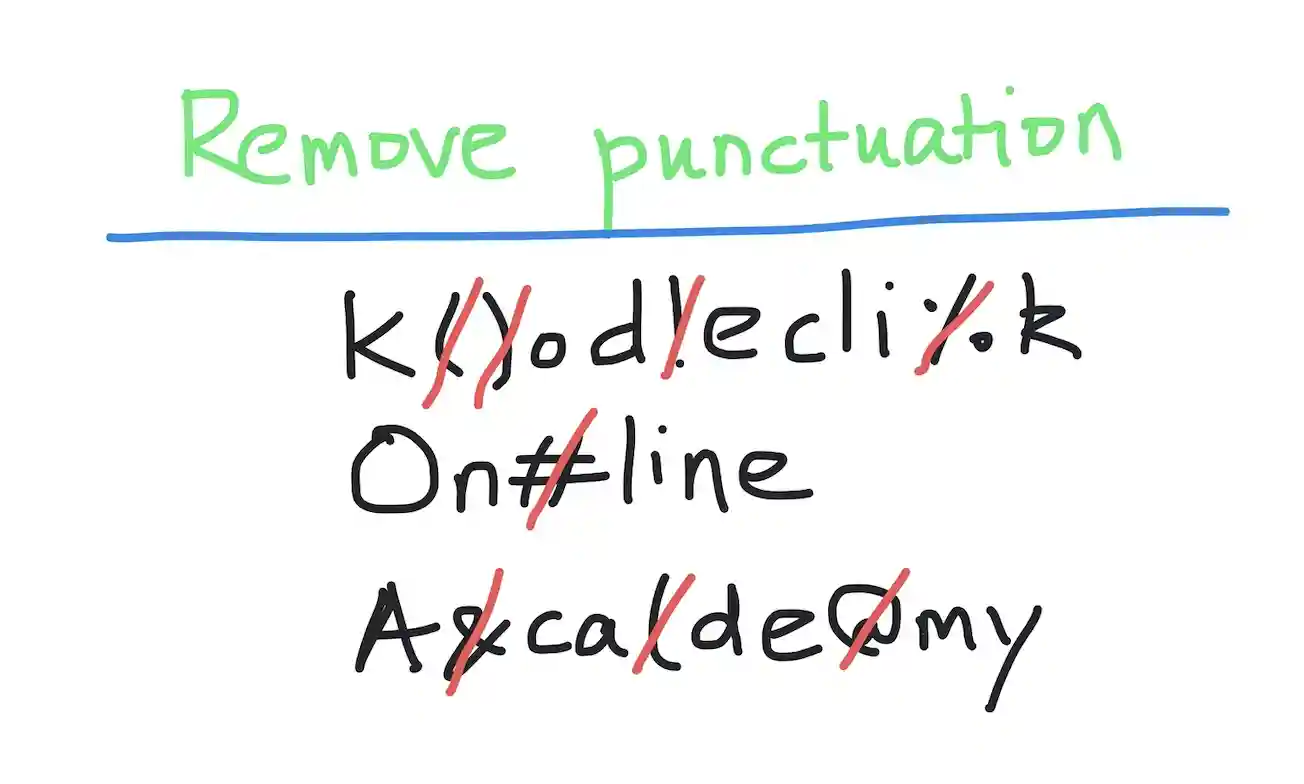Kodeclik Blog
How to remove punctuation from a Python string
Punctuation marks in strings can often hinder text analysis, natural language processing, or data processing tasks. Fortunately, Python offers several methods to remove punctuation from a string.
In this blog post, we will explore three different approaches to achieve this task.
Method 1: Use str.translate()
Python's str.translate() method allows for efficient removal of punctuation using translation tables.
But first we need to find a ready reference of punctuation characters that we wish to remove. This is obviously situation dependent but the Python string module has a ready list for us to use:
import string
print(string.punctuation)The output will be:
!"#$%&'()*+,-./:;<=>?@[\]^_\`{|}~which is as good a list as we might think of. So let us use this list. Next let us construct a Python string that contains some nuisance punctuation characters:
string_with_punctuation = "K()od!ecli%k On#line A&ca(de@my"As we can see this contains many nuisance characters that need to be removed.

Here is our main program that accomplishes our task:
import string
string_with_punctuation = "K()od!ecli%k On#line A&ca(de@my"
string_without_punctuation =
string_with_punctuation.translate(str.maketrans("","",string.punctuation))
print(string_without_punctuation)This program is a screenful so let us go over it in detail. It uses the string module whose sole purpose is to get for us the list of punctuation characters, It uses the maketrans() function which is part of the built-in Python str class. The maketrans() function is used to construct the transition table i.e specify the list of characters that need to be replaced in the whole string or the characters that need to be deleted from the string. The output of this function, i.e., the translation table, is used as the input to the translate method which does the actual replacements. The output is:
Kodeclik Online Academyas expected.
Method 2: Use the regular expressions (re) module
Regular expressions offer powerful pattern matching capabilities. The re module in Python can be employed to match and remove punctuation characters from strings.
import re
string_with_punctuation = "K()od!ecli%k On#line A&ca(de@my"
string_without_punctuation = re.sub(r'[^\w\s]','',string_with_punctuation)
print(string_without_punctuation)In the above code, we no longer need a “blacklist” of characters we wish to remove. The regular expression substitution function (re.sub) has a pattern matcher where we simply specify that any character other than a letter (\w) or space (\s) is considered to be punctuation and thus should be removed. Note the negation “^” symbol that is used in front of the pattern match. The output is:
Kodeclik Online AcademyMethod 3: Use a list comprehension
Python's list comprehension, combined with the str.join() method, provides an elegant way to remove punctuation from a string.
import string
string_with_punctuation = "K()od!ecli%k On#line A&ca(de@my"
string_without_punctuation =
''.join([char for char in string_with_punctuation
if char not in string.punctuation])
print(string_without_punctuation)Note that the string module is back as is the string.punctuation() function to give us a ready reference list of punctuation characters. Here we cycle through the string character by character and add it to the result (ie string_without_punctuation) only if it is not a punctuation character. The output is:
Kodeclik Online AcademyRemoving punctuation from a Python string is crucial for various text processing tasks. In this blog post, we explored three different methods: using string translation, regular expressions, and list comprehension. Which of these methods is your favorite?
If you liked this blogpost, see our discussion on how to remove (just) newlines from a Python string.
Interested in more things Python? Checkout our post on Python queues. Also see our blogpost on Python's enumerate() capability. Also if you like Python+math content, see our blogpost on Magic Squares. Finally, master the Python print function!
Want to learn Python with us? Sign up for 1:1 or small group classes.